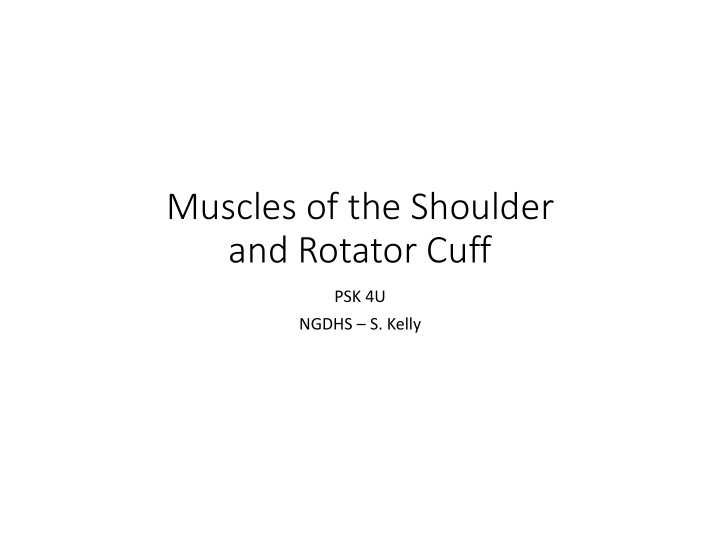



Muscles of the Shoulder and Rotator Cuff PSK 4U NGDHS – S. Kelly
Pectoralis Major • Large, fan-shaped muscle on anterior side of chest • Origin: sternum (sternal head) and clavicle (clavicular head) • Insertion: humerus • Action: internal rotation, flexion, and adduction of the arm • Inn: med, lat pec C7T1
Pectoralis Minor • Origin: ribs 3, 4, 5 • Insertion: 3 “heads” form a flat tendon which inserts on coracoid process (scapula) • Action: shoulder depression (pulls scapula down and in) • Innervation: medial pectoral (C8, T1)
Deltoid • Triangular muscle • Action: forming contour of • Flexion and abduction shoulder (anterior fibres) • Origins: • Abduction (medial fibres) • Lateral clavicle (anterior • Extension, lateral rotation, and hperextension fibres) (posterior fibres) • Acromion (medial fibres) • Injection site: 2 finger • Spine of scapula widths below acromion for (posterior fibres) intramuscular injection • Insertion: deltoid • Axillary C5C6 tuberosity of humerus
Deltoid Muscle
Deltoid muscle in situ
Coracobrachialis • Origin: coracoid process • Insertion: humerus • Action: adducts and flexes the arm • musculocutaneous
Teres Major • Origin: inferior angle of scapula • Insertion: bicipital groove of humerus • Action: stabilizer for medial rotation, adduction, and extension of the arm • Lower subscapular
Serratus Anterior • “Big swing” muscle or “Boxer’s muscle” (pulls scapula fwd, around ribcage as when throwing a punch) • Moves scapula laterally to allow for elevation of the arm • Moves scapula to allow one to lift objects over one’s head • Or: upper 8 or 9 ribs; ins: medial scapula • Innervation: long thoracic (C5, 6, 7)
Serratus Anterior
Rotator Cuff • Group of muscles • Shoulder stabilizers • 4 muscles of rotator cuff plus deltoid, teres major, coracobrachialis make up the scapulohumeral muscles (attach arm to body) • Overuse injuries are common in athletes making repetitive throw-like motions (most common tendon impinged is supraspinatus) • All 4 RC muscles originate on the scapula and insert on the humerus
Actions, Innervations of the Rotator Cuff Muscles • Supraspinatus: abducts the arm; suprascapular C5 • Infraspinatus: externally rotates the arm; suprascapular C5, C6 • Teres Minor: externally rotates the arm; axillary C5 • Subscapularis: internally rotates the arm (humerus specifically); upper and lower subscapular C5
Rotator Cuff Muscles
Scapulohumeral Group • Seven muscles that act on and stabilize the glenohumeral (shoulder ball and socket) joint • Rotator cuff + • Coracobrachialis • Deltoid • Teres major
Levator Scapulae • Origin: C vertebrae • Insertion: sup angle, medial border of scapula • Action: scapula elevation (fixed spine), C vertebrae flexion and rotation (fixed shoulder) • Inn: C4, C5, dorsal scapular
Levator Scapulae Action • Why is this unique (relative to what we are studying)? • When the spine is fixed, contraction elevates the scapula as its name suggests • HOWEVER, when the shoulder joint is fixed, it acts instead on the C spine as a flexor and weak lateral rotator • Can any part of the muscle shape facilitate these capabilities? **It needs other muscles’ help!!
Decent study diagram…
Recommend
More recommend